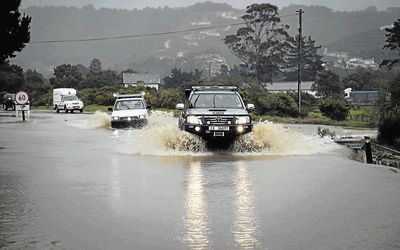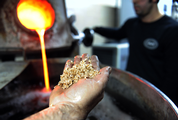RAIN showers across the country in recent weeks have come as a blessed relief from the debilitating heat wave, but the downpours will be bittersweet for farmers in drought-stricken provinces.
The rain has come too late to save their maize crops.
Planting season for maize was supposed to begin in September, which last year coincided with the onset of the drought. Some farmers delayed planting in the hope that the weather would improve.
About 1.4-million hectares were used to plant white maize, which is grown mostly in the west of the country ( the western Free State, KwaZulu-Natal and North West) and 1.2-million hectares used to plant yellow maize, grown in the east (Gauteng, Mpumalanga and the central and eastern Free State).
But most of the planting withered as the rain stayed away until late December. The white maize belt was hardest-hit.
Independent agricultural economist Fanie Brink says the rain is welcome, but that it has come very late in the season. "If there was maize planted in December, it is now only three weeks old and still very small. Anything could happen to it before harvest time."
GrainSA economist Petru Fourie says the direct losses in just the maize sector in terms of unplanted acreage amounts to more than R3bn.
"The yield potential of what was planted weakened as the drought continued. The bit of rain should allow for some improvement in crop conditions. However, losses have already occurred."
The drier weather conditions have been pinned on an exceptionally strong El Niño weather pattern.
Climate experts at the Council for Scientific and Industrial Research warned early last year that the strongest El Niño in more than half-a-century would hit SA the hardest between September last year and April this year.
The government was aware of the prediction. In November, it set up a response team called Team SA. The team implemented a number of measures including the purchasing of 45 water tankers of 18,000 litres each for use in the distribution of water in drought-affected areas, borehole drilling and rehabilitation, and water conservation and demand management measures.
Smallholder farmers were given feed and grazing land for their livestock, while a commitment was made to support revolving credit facilities with the Land Bank and other financial institutions to mitigate crop failure.
The total amount set aside for drought relief efforts country-wide was R524m.
"There isn’t much the government could have done before the drought set in, but they have been slow in their response," says Mr Brink. "There has been insufficient support for commercial farmers. (The) government spent R3bn in the drought of 1992 and this time, they have spent less than half of that. This not only has consequences for now, but knock-on effects for next season’s maize crops and prices."
AgriSA executive director Omri van Zyl estimates that R20bn will be needed to alleviate the effect of the drought in SA.
Commercial maize producers surveyed by the Crop Estimates Committee late last year had indicated they would plant 3.8% fewer hectares this year.
The South African Weather Service forecasts more rain in the next two weeks. But forecaster Ezekiel Sebogo says there could be more heat waves towards the end of the month and beyond.
Grains for Africa MD Joel Amoils says one only has to consider the futures market to gain the industry’s view on the prospects for maize.
The white maize spot price peaked at R4,960/tonne on January 5, before retreating to R4,600/tonne as the first rains in weeks soaked the land.
But by January 13, the spot price was on the rise again, closing at R4,830/tonne on the day.
"We are a weather market. The prices are seriously high. This could be an indication that there isn’t much hope for the yield or for rain," Mr Amoils says.
Barring a miracle, SA will most likely have to import maize.
The Bureau for Food and Agricultural Policy at the University of Pretoria expects a total maize crop of just 4.7-million tonnes, far less than half the industry average of about 11.5-million tonnes a year for 2011-15. The expected harvest is less than half of SA’s average consumption of 9.6-million tonnes a year over the period.
Ms Fourie says estimates are now that about 5-million tonnes of maize will have to be imported.
"The price of imported maize will not only be determined by the exchange rate, but also rests on the availability of maize and the country from which we have to import. Maize imports might cost SA between R17bn and R20bn."
White maize is a staple food and a preference in lower-income households in SA. Yellow maize is used mainly for animal feed and is a key input in the production of red meat and poultry.
The ripple effects of a smaller harvest of yellow maize include higher prices for chicken and eggs. The South African Poultry Association says higher input costs will result in producers raising prices to remain profitable.
Ms Fourie says it will be a challenge to source white maize outside Africa, although other African white maize producers are also facing drought.
Likely sources will be Mexico and the US. But there is doubt over whether enough white maize will be sourced from these countries. To meet demand, white and yellow maize meal may be mixed, as was done during the drought in 1992. However, this resulted in a drop in consumption because of consumer resistance.
Mr Brink says the government should approach the United Nations’ World Food Programme as soon as possible as the current and future food supply in the entire Southern African region is under threat.
"This problem should be addressed urgently to support the future sustainability of food production in the country on which the entire food chain depends."
Official estimates for crops are due for release on January 27.

RELIEF: While rain showers in recent weeks have taken the edge off the heat wave experienced in most cities, the downpours came too late for many farmers, whose maize crops have been decimated by drought. Picture: THE HERALD
RAIN showers across the country in recent weeks have come as a blessed relief from the debilitating heat wave, but the downpours will be bittersweet for farmers in drought-stricken provinces.
The rain has come too late to save their maize crops.
Planting season for maize was supposed to begin in September, which last year coincided with the onset of the drought. Some farmers delayed planting in the hope that the weather would improve.
About 1.4-million hectares were used to plant white maize, which is grown mostly in the west of the country ( the western Free State, KwaZulu-Natal and North West) and 1.2-million hectares used to plant yellow maize, grown in the east (Gauteng, Mpumalanga and the central and eastern Free State).
But most of the planting withered as the rain stayed away until late December. The white maize belt was hardest-hit.
Independent agricultural economist Fanie Brink says the rain is welcome, but that it has come very late in the season. "If there was maize planted in December, it is now only three weeks old and still very small. Anything could happen to it before harvest time."
GrainSA economist Petru Fourie says the direct losses in just the maize sector in terms of unplanted acreage amounts to more than R3bn.
"The yield potential of what was planted weakened as the drought continued. The bit of rain should allow for some improvement in crop conditions. However, losses have already occurred."
The drier weather conditions have been pinned on an exceptionally strong El Niño weather pattern.
Climate experts at the Council for Scientific and Industrial Research warned early last year that the strongest El Niño in more than half-a-century would hit SA the hardest between September last year and April this year.
The government was aware of the prediction. In November, it set up a response team called Team SA. The team implemented a number of measures including the purchasing of 45 water tankers of 18,000 litres each for use in the distribution of water in drought-affected areas, borehole drilling and rehabilitation, and water conservation and demand management measures.
Smallholder farmers were given feed and grazing land for their livestock, while a commitment was made to support revolving credit facilities with the Land Bank and other financial institutions to mitigate crop failure.
The total amount set aside for drought relief efforts country-wide was R524m.
"There isn’t much the government could have done before the drought set in, but they have been slow in their response," says Mr Brink. "There has been insufficient support for commercial farmers. (The) government spent R3bn in the drought of 1992 and this time, they have spent less than half of that. This not only has consequences for now, but knock-on effects for next season’s maize crops and prices."
AgriSA executive director Omri van Zyl estimates that R20bn will be needed to alleviate the effect of the drought in SA.
Commercial maize producers surveyed by the Crop Estimates Committee late last year had indicated they would plant 3.8% fewer hectares this year.
The South African Weather Service forecasts more rain in the next two weeks. But forecaster Ezekiel Sebogo says there could be more heat waves towards the end of the month and beyond.
Grains for Africa MD Joel Amoils says one only has to consider the futures market to gain the industry’s view on the prospects for maize.
The white maize spot price peaked at R4,960/tonne on January 5, before retreating to R4,600/tonne as the first rains in weeks soaked the land.
But by January 13, the spot price was on the rise again, closing at R4,830/tonne on the day.
"We are a weather market. The prices are seriously high. This could be an indication that there isn’t much hope for the yield or for rain," Mr Amoils says.
Barring a miracle, SA will most likely have to import maize.
The Bureau for Food and Agricultural Policy at the University of Pretoria expects a total maize crop of just 4.7-million tonnes, far less than half the industry average of about 11.5-million tonnes a year for 2011-15. The expected harvest is less than half of SA’s average consumption of 9.6-million tonnes a year over the period.
Ms Fourie says estimates are now that about 5-million tonnes of maize will have to be imported.
"The price of imported maize will not only be determined by the exchange rate, but also rests on the availability of maize and the country from which we have to import. Maize imports might cost SA between R17bn and R20bn."
White maize is a staple food and a preference in lower-income households in SA. Yellow maize is used mainly for animal feed and is a key input in the production of red meat and poultry.
The ripple effects of a smaller harvest of yellow maize include higher prices for chicken and eggs. The South African Poultry Association says higher input costs will result in producers raising prices to remain profitable.
Ms Fourie says it will be a challenge to source white maize outside Africa, although other African white maize producers are also facing drought.
Likely sources will be Mexico and the US. But there is doubt over whether enough white maize will be sourced from these countries. To meet demand, white and yellow maize meal may be mixed, as was done during the drought in 1992. However, this resulted in a drop in consumption because of consumer resistance.
Mr Brink says the government should approach the United Nations’ World Food Programme as soon as possible as the current and future food supply in the entire Southern African region is under threat.
"This problem should be addressed urgently to support the future sustainability of food production in the country on which the entire food chain depends."
Official estimates for crops are due for release on January 27.






















Change: 1.19%
Change: 1.36%
Change: 2.19%
Change: 1.49%
Change: -0.77%
Data supplied by Profile Data
Change: -0.19%
Change: 0.69%
Change: 1.19%
Change: 0.00%
Change: 0.44%
Data supplied by Profile Data
Change: 0.62%
Change: 0.61%
Change: 0.23%
Change: 0.52%
Change: 0.12%
Data supplied by Profile Data
Change: -0.21%
Change: -1.22%
Change: -0.69%
Change: -0.51%
Change: 0.07%
Data supplied by Profile Data